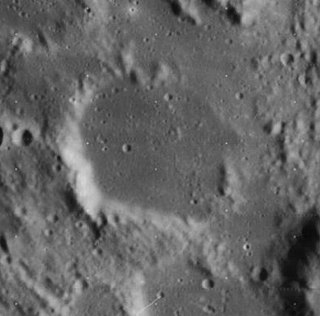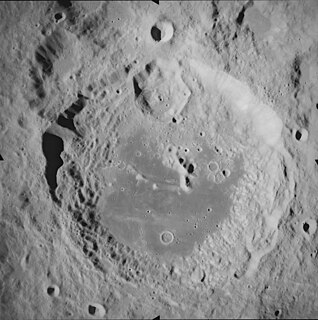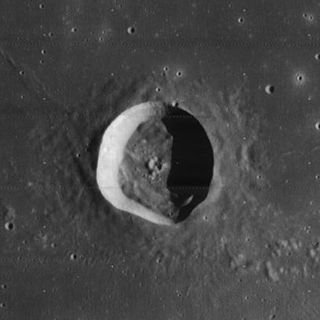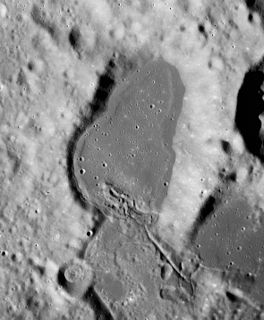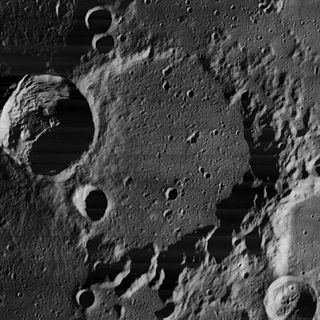This article includes a list of references, related reading or external links, but its sources remain unclear because it lacks inline citations .(February 2016) (Learn how and when to remove this template message) |
 Lunar Orbiter 4 image | |
| Coordinates | 76°42′S16°54′W / 76.7°S 16.9°W Coordinates: 76°42′S16°54′W / 76.7°S 16.9°W |
|---|---|
| Diameter | 79 km |
| Depth | 6.1 km |
| Colongitude | 18° at sunrise |
| Eponym | Isaac Newton |

Newton is a lunar impact crater located near the south limb of the Moon. It is south-southwest of the crater Moretus. To the northeast is Short, and in the northwest are Casatus and Klaproth. Because of its location, the crater appears highly oblong due to foreshortening. It is considered the deepest crater on the near side of the Moon.

Lunar craters are impact craters on Earth's Moon. The Moon's surface has many craters, almost all of which were formed by impacts.

An impact crater is an approximately circular depression in the surface of a planet, moon, or other solid body in the Solar System or elsewhere, formed by the hypervelocity impact of a smaller body. In contrast to volcanic craters, which result from explosion or internal collapse, impact craters typically have raised rims and floors that are lower in elevation than the surrounding terrain. Impact craters range from small, simple, bowl-shaped depressions to large, complex, multi-ringed impact basins. Meteor Crater is a well-known example of a small impact crater on Earth.

Earth's Moon is an astronomical body that orbits the planet and acts as its only permanent natural satellite. It is the fifth-largest satellite in the Solar System, and the largest among planetary satellites relative to the size of the planet that it orbits. The Moon is, after Jupiter's satellite Io, the second-densest satellite in the Solar System among those whose densities are known.
The interior of Newton is a picture in contrasts. The southern end has been covered, possibly by lava flows or ejecta, leaving a relatively flat surface that is marked only by tiny craters and a slight wrinkle ridge down the middle. The northern half is rugged and irregular, with the satellite crater Newton D overlying the north-northeastern rim and extending across nearly half the crater diameter.

Lava is molten rock generated by geothermal energy and expelled through fractures in planetary crust or in an eruption, usually at temperatures from 700 to 1,200 °C. The structures resulting from subsequent solidification and cooling are also sometimes described as lava. The molten rock is formed in the interior of some planets, including Earth, and some of their satellites, though such material located below the crust is referred to by other terms.
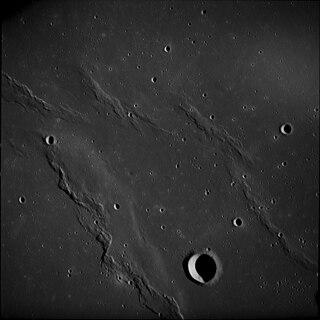
A wrinkle ridge is a type of feature commonly found on lunar maria. These features are low, sinuous ridges formed on the mare surface that can extend for up to several hundred kilometers. Wrinkle ridges are tectonic features created when the basaltic lava cooled and contracted. They frequently outline ring structures buried within the mare, follow circular patterns outlining the mare, or intersect protruding peaks. They are sometimes called veins due to their resemblance to the veins that protrude from beneath the skin. These are found near craters.
The rim in the south is relatively low and narrow, with the smaller crater Newton G partly overlain and flooded by lava. This adjacent crater forms a step up from the interior of Newton, and there is a tiny rille in the south floor of Newton where it appears as if a channel flowed down the side from Newton G. The other parts of the outer crater wall are much wider than in the south end, particularly in the areas adjacent to Newton D.

Rille is typically used to describe any of the long, narrow depressions in the surface of the Moon that resemble channels. The Latin term is rima, plural rimae. Typically a rille can be up to several kilometers wide and hundreds of kilometers in length. However, the term has also been used loosely to describe similar structures on a number of planets in the Solar System, including Mars, Venus, and on a number of moons. All bear a structural resemblance to each other.
